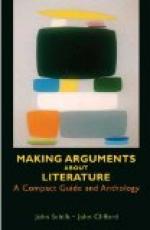24. The Place of the Refutation. The place of the refutation and its extent also differ greatly with the audience. Sometimes it may occupy practically the whole space. A few years ago The Outlook published an editorial opposing a change in the laws of New York relating to vivisection (for a part of it, see p. 44), in which it refuted the two arguments urged for the change, and then pointed out that the burden of proof still rested on the other side. Here the refutation occupied almost the whole of the argument. Huxley, in his three “Lectures on Evolution,” of which the first is printed on page 233, gave the whole of this first lecture to a refutation of the alternative theories of the origin of plants and animals; since it was necessary to dispose of accepted theories before the new theory could get a hearing, he put his refutation first.
Where there are no such special reasons, it is safe to follow the principle that you should not draw more attention than necessary to the arguments on the other side. Refutation of less important statements and contentions will naturally come at the point of the argument which deals with that part of the subject. State them fairly always, but do not magnify their importance by dealing with them at too great length.
It is not often wise to lump the refutation at the end of your argument. The last impression on your audience is the strongest: it is good strategy to keep it for your own best points. Sometimes, as in the brief worked out on page 90, it is possible to combine the refutation with positive argument which will be effective; but do not forget that negative argument makes much less impression than that which is positive and constructive.
25. The Brief Proper. We have seen on page 47 that the brief is in essence a statement of the logical framework of your argument. Its purpose is to lay out your reasoning in such a way that you can scrutinize each link and make sure that each assertion and each group of assertions is attached to a firm support. For this reason the brief for a written or spoken argument is best thrown into the form of tabulated statements marked with a series of numbers and letters which will show at a glance the exact place of each statement or assertion in the whole system of reasoning. When you can thus, as it were, strip your argument to its bones and tendons, you can go ahead with the confidence that your reasoning is logically coherent.
When you get out into the world you will work out your own way of making briefs for any arguments that fate imposes on you. The value of practice now is in being able to get at the work then without wasting time. The rules below are offered to you as the result of long experiment and study lay the best authorities. Moreover, if you are working in a class you should remember that you will get a great deal more out of your teacher if you save his time by sticking closely to uniformity in outward form.




